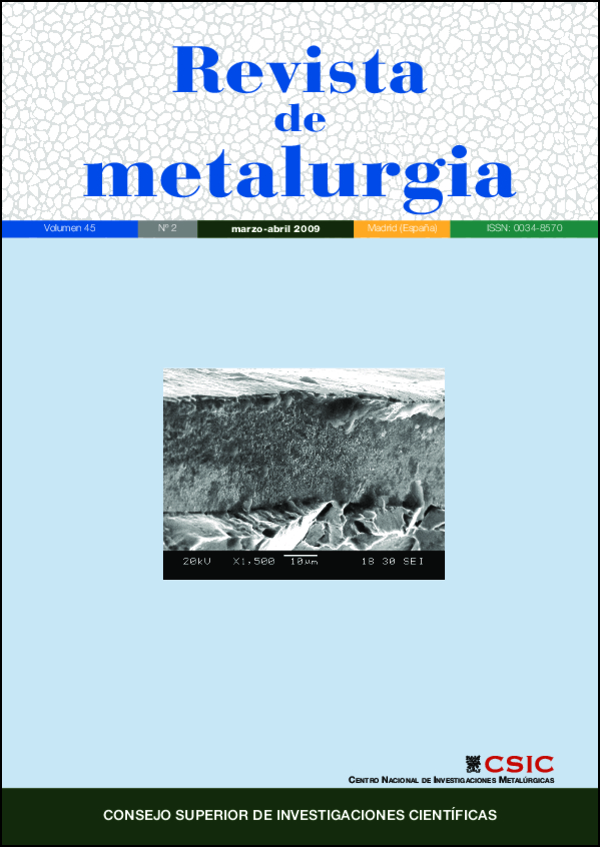Arsenic removal by using colloidal adsorption flotation utilizing Fe(OH)3 floc in a dissolved air flotation system
DOI:
https://doi.org/10.3989/revmetalm.0724Keywords:
Arsenic, Removal, Dissolved air flotation, Fe/As ratioAbstract
In the present work, the influence of Fe/As ratio on the As removal, from aqueous solutions, applying flotation by colloidal adsorption was studied. Ferric chloride was used as coagulant and dodecil sulfate as collector, and arsenic trioxide was utilized to preparing the solutions. The obtained results show that the highest arsenic removal was accomplished in the range of pH between 4 and 5,5, and the increasing of the initial concentration of Fe(III), increases the removal of arsenic from the solution. However, with the decreasing of the initial concentration of arsenic in the solution, it is required a larger Fe/As ratio for its removal. For solutions containing: 13,73, 1,71 and 0,105 mg/L of arsenic, it was shown that to remove around 95% of the dissolved arsenic, a Fe/As ratios of approximately 6/1, 18/1 and 800/1, respectively, are required.
Downloads
References
[1] F. Pérez-Moreno, F. Prieto-García, A. Rojas-Hernández, Y. Marmolejo- Santillán, E. Salinas- Rodríguez y F. Patiño-Cardona, Rev. Metal. Madrid. 42 (2006) 391-395.
[2] S. Yamamura, Global concern on the arsenic problem in drinking water and current response, Int. Sem. Latin American Experience in Environ mental Management, 2000, CENMA, Chile, 1-9.
[3] T. Yoshida, H. Yamauchi y G. Fan Sun, Toxicol. Appl Pharm. 198 (2004) 243-252. doi:10.1016/j.taap.2003.10.022 PMid:15276403
[4] R.R. Walvekar, S.V. Kane, M.S. Nadkarni, I.N. Bagwan, D.A. Chaukar y A.K.D. D” Cruz, J. Cutan. Pathol 34 (2006) 203-206. doi:10.1111/j.1600-0560.2006.00596.x PMid:17244035
[5] E. Kociolet-Balawejder y D. Ocinski, Przemysl Chemiczny 85 (2006) 19-26.
[6] A.H. Mirza, and V. Ramachandran, Removal of arsenic and selenium from wastewaters – A review. Second Int. Symp Extraction and Processing for the Treatment and Minimization of Wastes (Edited by Ramachandran, V. and Nesbitt, C.C.), The Minerals, Metals & Materials Society, 1996, p. 563.
[7] V.N. Tien, D.S. Chaudhary, H.H. Ngo y S. Vig - nes waran, J. Ind. Eng. Chem. 10 (2004) 337-348.
[8] L. Dambies, Sep. Sci. Technol. 39 (2004) 603- 627. doi:10.1081/SS-120027997
[9] O.M. Vatutsina, V.S. Soldatov, V.I. Sokolova, J. Johann, M. Bissen y A. Weissenbacher, React. Funct. Polym. 67 (2007) 184-201. doi:10.1016/j.reactfunctpolym.2006.10.009
[10] B. Nayak, M.A. Hossain, M.K. Sengupta, S.Ahamed, B. Das, A. Pal y A. Mukherjee, Water. Qual Res. J. Can. 41 (2006) 333-340.
[11] V.K. Gupta, V.K. Saini y N. Jain, J. Colloid Interf. Sci. 288 (2005) 55-60. doi:10.1016/j.jcis.2005.02.054 PMid:15927561
[12] H. Garelick, A. Dybowska, E. Valsami-Jones y N.D. Priest, J.Soils Sediments 5 (2005) 182-190. doi:10.1065/jss2005.06.140
[13] P. Westerhoff, D. Highfield, M. Badruzzaman y Y. Yoon, J. Environ. Eng. Asce 131 (2005) 262- 271. doi:10.1061/(ASCE)0733-9372(2005)131:2(262)
[14] S.R. Wickramasinghe, H. Binbing, J. Zimbron, Z. Shen y M.N. Karim, Desalination 169 (2004) 231-244.
[15] J. Iqbal, H.J. Kim. J.S. Yang, K. Baek y J.W. Yang, Chemosphere 66 (2007) 970-976. doi:10.1016/j.chemosphere.2006.06.005 PMid:16884764
[16] M.P. Elizalde-González, W.D. Mattusch, D. Einicke y R. Wennrich, Chem. Eng. J. 81 (2001) 187-195. doi:10.1016/S1385-8947(00)00201-1
[17] S. Shevade y R.G. Ford, Water Res. 38 (2004) 3.197-3.204.
[18] S. Nakashima, Analyst 103 (1978) 1031-1036. doi:10.1039/an9780301031
[19] E.H. De Carlo y H. Zeitlin, Anal. Chem., 53 (1981) 1.104-1.107.
[20] X. Feng y D.E. Ryan, Anal. Chem. Acta 162 (1984) 47-55. doi:10.1016/S0003-2670(00)84226-9
[21] E.H. De Carlo y D.M. Thomas, Environ. Sci. Technol. 19 (1985) 538-544. doi:10.1021/es00136a009
[22] X. Xiaoyuan, C. Jin y G. Changhuai, XVII th Int. Mineral Processing Congress, Dresden, 1991, p. 419-427.
[23] F.F. Peng y P. Di, Ind. Eng. Chem. Res. 33 (1994) 922-928. doi:10.1021/ie00028a020
[24] Y. Zhao, A.I. Zouboulis y K.A. Matis. Sep. Sci. Technol. 31 (1996) 769-785. doi:10.1080/01496399608001323
[25] G.B. Harris, S. Monette, The estability of arsenic – bearing residues. In: Arsenic Metallurgy – Fundamentals and Applications, eds. R.G. Reddy, J.L. Hendrix y P.B. Quenau, The Metallurgical Society of AIME, Warrendale, Pennsylvania, 1988, p. 469.
[26] N. Papassiopi, M. Stefanakis y A. Kontopoulos, Removal of arsenic from solutions by precipitation as ferric arsenates. In Arsenic Metallurgy – Fundamentals and Applications, eds. R.G. Reddy, J.L. Hendrix, y P.B. Quenau. The Metallurgical Society of AIME, Warrendale, Pennsylvania, 1988, p. 321.
[27] E. Krause y V.A. Ettel, Hydrometallurgy 22 (1989) 311-337. doi:10.1016/0304-386X(89)90028-5
[28] J. Nanor, M. Misra, S. Chen, Characterization of iron – arsenate and lanthanum – arsenate precipitated compounds. In Analytical Technology in the Mineral Industries, eds. Cabri, J.L., Buckman, C.H., Milosavljevic, E.B., Chryssoulis, S.L. and Miller, R.A., The Minerals, Metals & Materials Society, 1999, p. 95.
[29] G.A. Parks, Chem. Rev. 65 (1965) 177-198. doi:10.1021/cr60234a002
[30] G.A. Parks, Adsorption in the marine environment, Chemical Oceanography, eds. J.P. Riley and G. Skirrow, Academic Press, 2nd edition, 1975, chapter 4, p. 241.
[31] T.E. Chatmann, S.D. Huang and D.J. Wilson, J. Sep. Sci. 12 (1977) 461-484. doi:10.1080/00372367708058090
Downloads
Published
How to Cite
Issue
Section
License
Copyright (c) 2009 Consejo Superior de Investigaciones Científicas (CSIC)

This work is licensed under a Creative Commons Attribution 4.0 International License.
© CSIC. Manuscripts published in both the printed and online versions of this Journal are the property of Consejo Superior de Investigaciones Científicas, and quoting this source is a requirement for any partial or full reproduction.
All contents of this electronic edition, except where otherwise noted, are distributed under a “Creative Commons Attribution 4.0 International” (CC BY 4.0) License. You may read the basic information and the legal text of the license. The indication of the CC BY 4.0 License must be expressly stated in this way when necessary.
Self-archiving in repositories, personal webpages or similar, of any version other than the published by the Editor, is not allowed.
















